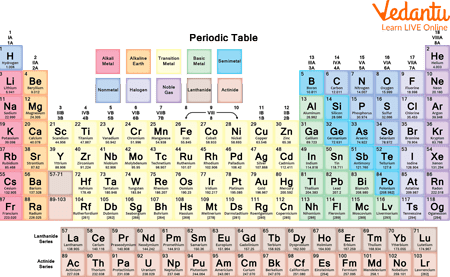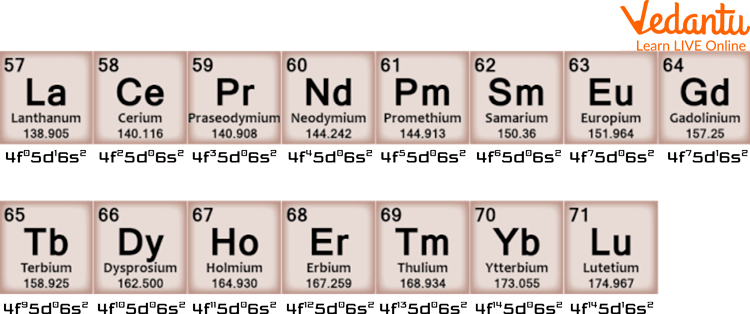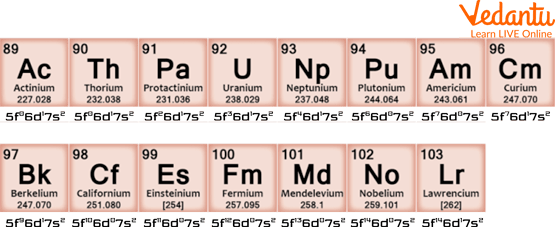




Overview of Lanthanides and Actinides
Lanthanides and Actinides are radioactive in nature. They consist of 30 elements in total. They contain radioactive elements such as Uranium. These elements are kept in the lanthanide and actinide series of periodic tables. Here, we will learn what are the Lanthanides and Actinides. After reading this article you will be able to answer questions like give the general electronic configuration of lanthanides and actinides, and the number of radioactive elements among lanthanides and actinides. Also, we will learn the applications of lanthanides and actinides.

Periodic Table
Lanthanides
Lanthanides contain elements from the atomic numbers 57 to 71. These elements are named after the first element in the group called lanthanum, as it exhibits similar chemical properties to all other elements in the group.
It contains 15 elements and is referred to as Ln by chemists. The elements in this group include Lanthanum, Cerium, Praseodymium, Neodymium, Promethium, Samarium, Europium, Gadolinium, Terbium, Dysprosium, Holmium, Erbium, Thulium, Ytterbium, and lutetium.
These 15 elements are also called Rare Earth Metals and are all silvery-white reactive solid metals obtained from the same ore.

Lanthanides and their Electronic Configuration
Actinides
These are 15 elements that start with the atomic number 89 and go up to the atomic number 103. They are called Actinides as they all display similar chemical properties to the first element of the group Actinium. The symbol An is used to refer to actinides. This group includes mostly man-made elements other than a few that are naturally occurring. It includes Actinium, Thorium, Protactinium, Uranium, Neptunium, Plutonium, Americium, Curium, Berkelium, Californium, Einsteinium, Fermium, Mendelevium, Nobelium, and Lawrencium.

Actinides and their Electronic Configuration
Differences between Lanthanides and Actinides
Differences between Lanthanides and Actinides are listed in the table below.
What Makes These Elements Special?
Actinides are radioactive elements. Due to their property of radioactivity, they are especially useful in nuclear reactions, and they emit radiation. One Lanthanide (Promethium and all its isotopes) is radioactive, while the others are not. The total number of radioactive elements in Lanthanides and Actinides is 16. If someone asks to give the general configuration of Lanthanides and Actinides, you can tell that Actinides have a general configuration of 4f n 5d0 6s2 and that of Lanthanides 5f1-14 6d0-1 7s2
Interesting Facts
Some of the most interesting facts about lanthanides and actinides include:
Lanthanides and Actinides are considered F-block elements as they have one or more electrons in the inner f orbital. However, some are also considered d block elements.
Lanthanides are silver/white coloured metals that tarnish in the air due to their reactivity.
Lanthanides have high melting and boiling points and react with water to produce hydrogen gas.
Many lanthanides burn when exposed to air.
Monazite, Xenotime, and euxenite are the main lanthanide ores.
Uranium and thorium are the most abundant naturally occurring actinides while plutonium is a synthetically obtained actinide.
Actinides have heavy densities except for thorium and americium.
Actinide metals are quite soft.
Lanthanides and Actinides are also called inner transition elements.
The number of radioactive elements among lanthanides and actinides is 16.
Summary
In this article we have discussed all important topics related to lanthanides and actinides. Lanthanides and Actinides are two groups of elements in the periodic table known as inner transition elements. They are mostly metallic elements that are placed below the periodic table in two rows. Actinides are radioactive and consist of elements from atomic numbers 89 to 103. Lanthanides consist of elements with atomic numbers 58 to 71. Combined they consist of 30 elements. Now, you can easily answer questions like give any two differences between lanthanides and actinides. In case of doubts feel free to ask in the comments.
FAQs on What are the Lanthanides and Actinides?
1. What are the applications of Lanthanides and Actinides?
Uses of Lanthanides and Actinides include the following:
Lanthanides
They are used in optical devices such as night vision goggles, laser beams, etc.
They are often used as alloys to strengthen and harden metals. Cerium is the major lanthanide used for this purpose along with Lanthanum, Neodymium, and Praseodymium in small amounts.
Used to refine crude oil into petroleum products in the refining industry.
Actinides
Radioactive property possessed by actinides allows them to be used to create nuclear energy in power plants. Uranium and Plutonium are also used in nuclear weapons.
Useful in appliances such as Cardiac Pacemakers.
Used to produce electricity for instruments working on the moon!
2. What is the total number of radioactive elements in Lanthanides and Actinides?
The total number of radioactive elements in Lanthanides and Actinides is 16. All Actinides are radioactive, and one Lanthanide called Promethium is radioactive in nature.
3. What are Lanthanides and Actinides also called?
Lanthanides and Actinides are also called Rare Earth elements. Sometimes they are referred to as inner transition elements as well.
4. Why are Lanthanides and Actinides placed separately in the periodic table?
Lanthanides and Actinides are placed separately in the periodic table. Lanthanides are placed above actinides. The reason for their separate placement is due to their electronic configuration. The general electronic configuration of the two groups is such that they contain electrons in the inner f orbital.









